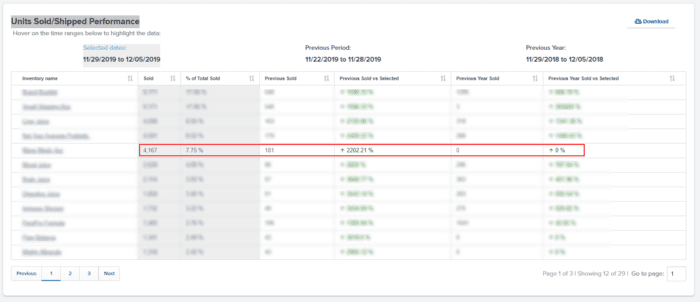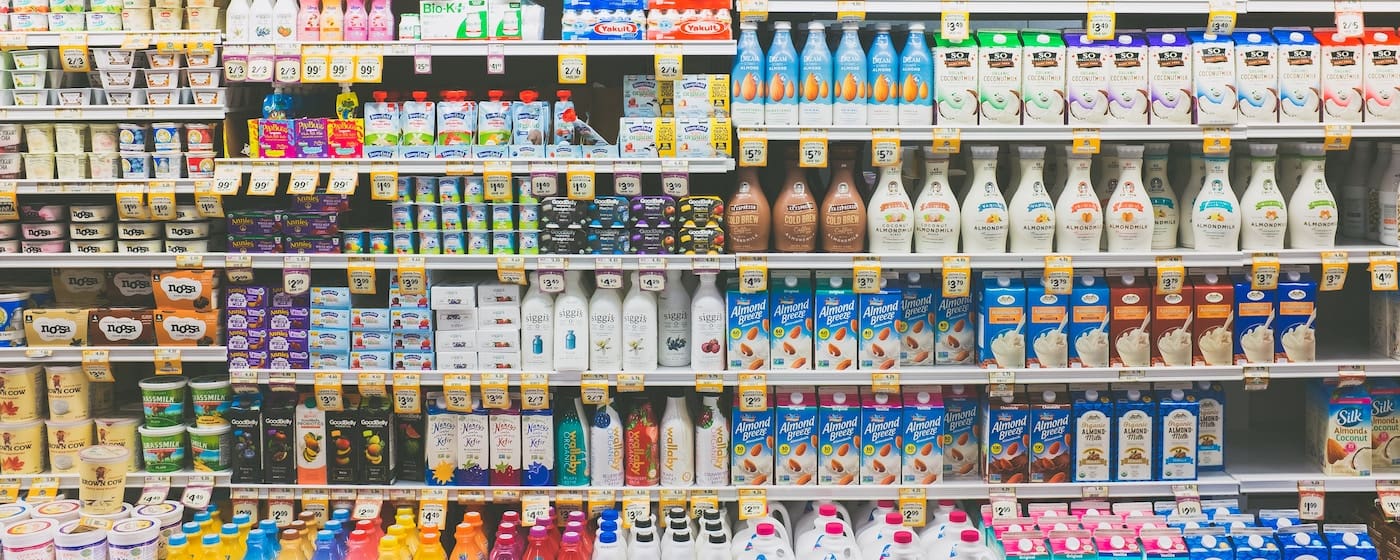Table of Contents
** Minutes
Product assortment strategies for 2023
The future of product assortment
ShipBob’s inventory management can help optimize your product assortment
If you run an ecommerce business, you have a lot of competition.
Back in 2020, Shopify saw an increase of nearly 800,000 new merchants during the pandemic – and with a whopping 26 million ecommerce websites in existence as of 2022, industry growth doesn’t seem to be slowing down any time soon.
So in this sea of competitors, how do you carve out a niche for your brand?
It starts with the products you sell.
To build a viable, lucrative assortment of products that promotes profitability, you need a product range that attracts the target customers, keeps SKU proliferation in check, and enables you to compete in highly-saturated ecommerce markets.
Achieving that range requires an assortment planning process. To develop your brand’s ideal product assortment, you’ll need a strategy – one that accounts for your capabilities, target audience, and industry, and that includes great partners to help you execute it.
In this article, we’ll offer a comprehensive guide to different product assortment strategies you should consider, key challenges to plan for, and how the right 3PL partner can help.
What is product assortment?
Also called merchandise mix, product assortment refers to the variety of items your business sells.
There are two main components to consider in product assortment: the width (or breadth), and the length (or depth). Businesses need to find the right balance between the two to determine the ideal assortment strategy.
Width or breadth refers to how diverse your product assortment is – in other words, how large of a variety of product lines and categories your business sells.
For example, retailers such as Amazon have a wide product assortment, as they sell everything from clothing to crafting supplies to furniture.
Length or depth refers to the number of variations your business sells within a specific category or product line. The more variations you offer, the deeper your product assortment is.
For example, a furniture brand with a long product assortment may only sell bookshelves, but offers those bookshelves in many different designs and color options.
Why is product assortment important?
Product assortment has huge ramifications for your customers and your bottom line. Here are just some of the reasons why product assortment is critical to your business.
It improves the customer experience
Combined with good catalog management, the right product assortment can ensure that people can find exactly what they need.
When your assortment is optimized for consumer demand, your brand will be able to serve more customers and provide a delightful – rather than disappointing – shopping experience.
It drives sales
When you offer your customers the right mix of products, your brand streamlines the buying process.
Rather than overwhelming them with too many options, you make it easier to meet customer needs from your available inventory, minimizing the chances that they’ll turn to a competitor. This encourages customers to purchase, and drives more sales for your brand.
It can boost profits
When your product assortment is optimized, your brand will only stock the items you need to meet customer demand.
This helps you avoid spending money to store stock that never sells, and improves inventory turnover – both of which are key to increasing revenue and profit margins.
Product assortment strategies for 2023
There are five main types of assortment strategies that can be used by ecommerce stores and brick-and-mortar retailers alike.
Wide assortment
A wide assortment strategy involves offering a broad array of product types and categories, but few selections or variations within them. This allows retailers to cater to the needs of a much larger audience.
For example, box box pharmacies like Walgreens or CVS carry a little bit of everything, from diapers to groceries, medicine to greeting cards.
That way, people can usually find what they’re looking for in one store – as long as they don’t mind having fewer options when it comes to the design or brand name of individual items.
Deep assortment
Using a deep assortment strategy, businesses limit their product categories, but offer a wide variety of items within each category.
This enables them to cater to the needs and interests of a very specific audience, so they can greatly improve satisfaction for the customer base that cares more about features like design, quality, price, and more.
For example, shoe brand Zappos specializes in footwear. While they do not sell many products other than shoes, they offer a large variety of shoe styles to cater to many different preferences across customers (as well as specialty shoes for different foot widths, and even single shoes).
Scrambled assortment
A scrambled assortment strategy involves offering a few products that are outside of your core product mix.
In other words, you’re going beyond your brand’s primary focus to provide additional items that would appeal to customers who don’t belong to your usual segments. With this strategy, businesses can attract new customers and drive more sales.
For example, a craft store like Michaels primarily focuses on selling craft supplies. However, it may decide to scramble its product assortment by offering additional items, such as baking supplies, toys, and home decor.
That way, a shopper who is visiting the store to get materials for a project can also buy some seasonal house decorations without visiting a different store, allowing the store to make more sales.
Mass market
Mass market assortment strategies are designed to cater to as many customers and demographics as possible, which means the product assortment is both wide and deep.
In a mass market strategy, a business carries a vast category of products, and offers a huge variety of options within each category.
For example, big-box retailers such as Walmart adopt a mass market assortment strategy, offering a massive selection of products across hundreds of categories.
In each of these categories, customers are also able to browse hundreds (and sometimes even thousands) of product variations.
Although a mass market assortment strategy is ideal for getting the most revenue, it’s also the most challenging to maintain. It requires enormous storage capabilities, which involve significant investment and high maintenance costs. As such, it’s typically feasible only for retail giants.
Localized assortment
In a localized assortment strategy, the product mix is adjusted according to the store’s location.
That means the store will change its assortment of products based on the needs and demands of the local community within a specific region. These needs may vary depending on factors such as climate, terrain, culture, and events.
For example, a hardware store chain may sell shovels and space heaters in a state that sees harsh winters. Meanwhile, a different retail location would stock items such as sprinklers and solar panels in a state with warmer weather such as Florida.
Product assortment challenges
Whether you’re running a brick-and-mortar store or an ecommerce business, deciding on the right product assortment isn’t an easy task. Here are some of the key challenges that you’ll need to consider when choosing which products to sell.
Assortment size and diversity
While you may want to stock a wide variety of products across a vast range of categories, this may not always be feasible for your business.
Maintaining a large inventory can be difficult, and if your brand attempts too ambitious of a product assortment, you could get overwhelmed with the sheer variety of items that need to be stocked, restocked, and fulfilled.
Small stores and brands will need to think carefully about what product assortment their infrastructure and business model can support.
Capacity constraints in shelf space
Both ecommerce retailers and brick-and-mortar stores have capacity limits. Even if you want to offer a variety of items or different types of products, you may not necessarily have the floor or shelf space to stock all of those items in your store or warehouse.
To avoid exceeding storage capacity, monitor inventory turnover and inventory days on hand at the SKU level. This way, you can see quickly your business uses up available stock on average, and how to time replenishment in such a way that there will be space to store new inventory.
Workforce allocation
As businesses diversify their product assortment, they may have an increased need for workers to manage their inventory at a detailed level. However, this may increase operational costs significantly.
Before changing your product assortment, make sure to consider whether your inventory management and fulfillment team can handle receiving, storing, picking, packing, and shipping new SKUs. If you anticipate higher order volumes with the new additions, make sure your team is prepared, and can still provide quick fulfillment and delivery.
If any of your teams can’t support a growing product assortment, there are a few other options. You can add workers to your team (though this may increase labor costs), or you can partner with a 3PL that can help you store your inventory and fulfill orders more efficiently.
SKU proliferation
As your brand adds to its product assortment over time, you may start to accumulate more SKUs than you can realistically handle. When left unchecked, this SKU proliferation can lead to issues with inventory visibility, increased carrying costs, and deadstock.
Preventing SKU proliferation starts with regular inventory audits to get rid of obsolete inventory and catch potential deadstock early.
Businesses should also conduct SKU rationalization periodically, examining inventory performance at the SKU level periodically to identify slow-moving SKUs that need to be discontinued from their product line.
This enables them to decrease holding costs, allocate their capital towards more profitable SKUs, and keep their assortment size manageable.
“We knew we couldn’t focus so much of our time and energy on shipping and fulfillment, and so we set out to find a 3PL partner.
After starting our search, we found that many 3PLs were not interested in working with us because we had too many SKUs and not enough volume to work with them. Others lacked the ability to ship internationally or only shipped using one carrier.
We then found ShipBob, who checked all the boxes. They have ended up being the perfect solution for us and we have never looked back!”
Waveform Lighting team
The future of product assortment
As purchasing habits shift in the aftermath of the pandemic, brands may find product assortment strategies shifting as well.
When stay-at-home orders closed retail stores, customers increasingly turned to ecommerce platforms to get staples and splurges alike. As a result, ecommerce sales increased by 43% in 2020 alone, growing from $571.2 billion in 2019 to $815.4 billion.
This growth spurred many predominantly brick-and mortar businesses (retailers especially) to adopt a more omnichannel approach.
By investing more in their online and social sales channels, brands were able to capture more demand – even after health restrictions were lifted and in-store shopping resumed.
Ecommerce channels naturally lend themselves to wider product assortments, since online businesses use larger warehouse storage spaces (rather than smaller retail shelves), and can therefore often offer a wider mix of product categories.
This means that, as more brands focus on ecommerce, merchants may see product assortments widen more than they have in previous years.
Product assortments are also widening as a result of better inventory management technology. With modern inventory management systems offering increased visibility, better tracking, SKU analysis tools, and real-time data, businesses can now manage more SKUs at a time, and make more informed assortment decisions.
This may be concerning for smaller, DTC ecommerce brands – particularly as big box retailers widen assortments. However, DTC merchants can help distinguish themselves by building deeper product assortments, which retail giants often struggle to achieve.
Brands can do this in two main ways:
- They can provide customers a deeper product assortment through their own online storefront, and continue selling and fulfilling DTC.
- They can partner with a retailer, using their products to deepen the retailer’s assortment and getting their products in front of more customers.
ShipBob’s inventory management can help optimize your product assortment
As a best-in-class fulfillment partner, ShipBob provides ecommerce and retail fulfillment solutions for brands looking to manage and grow their product assortments.
ShipBob’s dashboard includes powerful inventory management capabilities, so you can efficiently track and manage all your SKUs across all your channels through one platform.
These solutions give you the leverage you need to optimize your product assortment for long-term growth.
Optimized fulfillment solution
ShipBob partners with over 7,000 ecommerce brands to optimize inventory storage, order fulfillment, and shipping.
With a global network of 40+ fulfillment centers, dozens of direct integrations, and a full customization suite, ShipBob has the resources and expertise to fulfill orders across a wide range of industries.
This means that even if you decide to add hundreds of new SKUs to your merchandise mix, ShipBob can help you manage them and continue to fulfill orders efficiently, and accurately.
Data-led decisions with SKU analytics
ShipBob’s built-in analytics dashboard provides your business with robust SKU analytics, so you can understand inventory performance at the SKU level.
Using metrics like on-hand inventory, SKU performance, and average units sold per day, you can pinpoint which products are popular or slow-moving, and how to diversify or expand your product assortment.


“ShipBob’s analytics tool is also really cool. It helps us a lot with planning inventory reorders, seeing when SKUs are going to run out, and we can even set up email notifications so that we’re alerted when a SKU has less than a certain quantity left. There is a lot of value in their technology.”
Oded Harth, CEO & Co-Founder of MDacne
Advanced forecasting to help with procurement planning
ShipBob tracks sales and order history for your brand over time, so you can leverage that data to forecast demand more accurately. With better forecasting, you can better plan your procurement to maintain optimal stock levels across all your SKUs.
Along with inventory performance data and turnover ratio, your brand can improve your production forecasting and make timely replenishment orders using automatic reorder notifications.
“We roll out new products and designs on our website 1-3 times a month and send new inventory to ShipBob each week. It’s really easy to create new SKUs and restock existing ones using ShipBob’s technology, which is especially important with high inventory turnover.”
Carl Protsch, Co-Founder of FLEO
If you want to learn more about how ShipBob can help you manage and expand your product assortment, click the button below.
Product assortment FAQs
Below are answers to the most common questions about product assortment.
How does the product assortment of a business affect its supply chain and logistics operations?
A business’ product assortment plays a vital role in the overall supply chain, particularly when it comes to sourcing and storage. Having a wide or deep product assortment also affects logistics operations, as businesses must figure out an efficient way to fulfill and ship all items in their product mix.
How does the size of a business impact the size and scope of its product assortment?
Larger businesses typically cater to a bigger audience, which calls for a wider and deeper product assortment. Moreover, they may also have better resources and more capacity to manage a bigger assortment.
How can ShipBob help businesses manage their product assortment?
ShipBob provides SKU-level visibility into inventory, allowing businesses to track SKU performance and optimize their assortment accordingly.
What is the difference between product assortment and product line?
Product assortment refers to the entire variety of items that are sold by your business. Product line, on the other hand, refers to a range of products that share some similarity, and are sold by the same brand.



